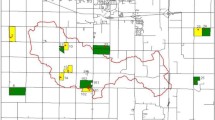Summary
Three aerodynamic formulae were used to compute evapotranspiration from a cornfield, and results compared with estimates from the energy budget and with measurements from a floating lysimeter. The aerodynamic methods yielded results which were close to the lysimeter measurements when the corn was short at the beginning of the season, but fell to only 40% of the measured values at the end of the season. These results may indicate that the conditions for the validity of the formulae are not likely to be realized in an ordinary cornfield. In addition to the bias toward underestimation, many large random errors occurred in the calculated evapotranspiration. These are attributed to the inability of present instrumentation to measure the meteorological parameters with sufficient precision to meet the requirements of the aerodynamic formulae.
It is concluded that aerodynamic methods, when applied to calculating evapotranspiration from tall crops, cannot be expected to yield useful results, and it is recommended that the energy budget method, which was found to estimate evapotranspiration within 11% of measured values, be used instead.
Zusammenfassung
Die Evapotranspiration von einem Kornfeld wurde mit Hilfe von drei verschiedenen aerodynamischen Formeln berechnet und die Resultate wurden mit Schätzungen aus dem Wärmehaushalt und mit Messungen mit einem Lysimeter verglichen. Die aerodynamischen Methoden ergaben Resultate, die nahe den Lysimetermessungen lagen, solange das Korn zu Beginn der Wachstumszeit kurz war. Sie fielen jedoch am Ende der Wachstumszeit auf 40% der gemessenen Werte ab. Diese Ergebnisse legen den Schluß nahe, daß die Voraussetzungen für die Gültigkeit der Formeln wahrscheinlich in einem gewöhnlichen Kornfeld nicht erfüllt sind. Neben den grundsätzlichen Unterschätzungen traten auch viele zufällige Abweichungen in den berechneten Evapotranspirationswerten auf. Diese werden der Tatsache zugeschrieben, daß die gegenwärtigen Instrumente die meteorologischen Parameter nicht mit der Genauigkeit zu messen gestatten, die für die Anwendung der aerodynamischen Formeln nötig wäre.
Es wird der Schluß gezogen, daß von aerodynamischen Methoden keine verwendbaren Ergebnisse erwartet werden können, wenn sie zur Berechnung der Evapotranspiration von hohen Gewächsen angewandt werden, und es wird empfohlen an ihrer Stelle die Methoden zur Abschätzung aus dem Wärmehaushalt zu verwenden, mit der die Evapotranspiration auf 11% genau berechnet werden konnte.
Résumé
On a calculé l'évapotranspiration d'un champ de blé au moyen de trois formules aérodynamiques différentes. Le résultat de ces calculs a été comparé à des estimations de l'économie thermique et à des mesures faites au moyen d'un lysimètre. Les méthodes aérodynamiques présentent des valuers voisines des mesures lysimétriques pour autant que le blé est court, c'est-à-dire au début de sa phase de croissance. Elles n'indiquent par contre plus que 40% des valeurs mesurées à la fin de la période de croissance. Ceci laisse à penser que les conditions réclamées par ces formules ne sont plus remplies dans un champ de blé ordinaire. A côté des sousestimations fondamentales, on a rencontré bien des variations par rapport aux valeurs calculées de l'évapotranspiration. On attribue ces écarts au fait que les instruments disponibles ne permettent pas de mesurer les paramètres météorologiques avec suffisamment de précision pour permettre d'appliquer les formules aérodynamiques.
On en conclut que les méthodes aérodynamiques ne fournissent pas de valeurs utilisables de l'évapotranspiration de cultures hautes. On recommande au contraire d'utiliser à leur place une appréciation de l'économie thermique. Il est alors possible de calculer l'évapotranspiration avec une erreur de 11%.
Similar content being viewed by others
References
Deacon, E. L.: Vertical Diffusion in the Lowest Layers of the Atmosphere. Quart. J. Roy. Met. Soc.75, 89 (1949).
Monim, A. S., andA. M. Obukhov: U.S.S.R. Acad. Sci. Works of Geophys. Inst. No. 24 (1954).
Sheppard, P. A.: Transfer Across the Earth's Surface and Through the Air Above. Quart. J. Roy. Met. Soc.84, 205 (1958).
King, K. M., C. B. Tanner, andV. E. Suomi: A Floating Lysimeter and Its Evaporation Recorder. Trans. Amer. Geophys. Union37 (6), 738–742 (1956).
Funk, J. P.: J. Sci. Instr.36, 267 (1959).
Author information
Authors and Affiliations
Additional information
With 5 Figures
Rights and permissions
About this article
Cite this article
Mukammal, E.I., King, K.M. & Cork, H.F. Comparison of aerodynamic and energy budget techniques in estimating evapotranspiration from a cornfield. Arch. Met. Geoph. Biokl. B. 14, 384–395 (1966). https://doi.org/10.1007/BF02243368
Received:
Issue Date:
DOI: https://doi.org/10.1007/BF02243368




